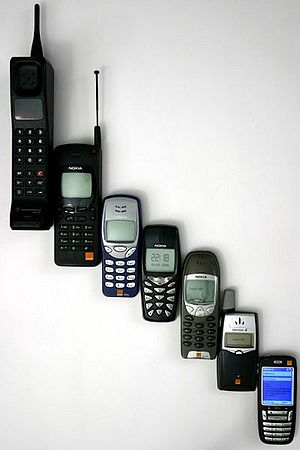Cellular telephone
A cellular telephone is a hand held device used for communicating, commonly known as a "cell phone" in the United States, and also known as a "mobile phone" in Britain, Ireland and Australia.
History
The principle behind cell phones, transmitting waves modulated with sound signals (see methodology) was first seen in radio communications developed in the 1920's. However the potential of this technology was not realised for many years, and the move towards the networks used today did not begin until 1947, when Bell Laboratory engineers Douglas Ring and Rae Young proposed using hexagonal grids with base towers at the corners (rather than in the centers) to allow communication. This creation of the "cellular concept" resulted in increased research into the possibility of evolving commonly used 2-way radio communication into real time speech.
The following is a summary of jurisdictions that have regulated the use of hand-held cell phones while driving (as of April 2008):
- California, Connecticut, District of Columbia, New York, New Jersey and, beginning July 2008, Washington.[1]
- Illinois, Massachusetts, Michigan, New Mexico, Ohio, and Pennsylvania permit local municipalities to ban handheld cell phone use. Localities that have already done this include: Chicago, IL; Brookline, MA; Detroit, MI; Santa Fe, NM; Brooklyn, North Olmstead and Walton Hills, OH; and Conshohocken, Lebanon and West Conshohocken, PA.
- Florida, Kentucky, Louisiana, Mississippi, Nevada, Oklahoma, Oregon, and Utah do not allow local governments to ban cell phone use.
- Arizona, Arkansas, California, Connecticut, Delaware, District of Columbia, Illinois, Massachusetts, New Jersey, Rhode Island, Tennessee, and Texas ban the use of all cell phones while driving a school bus.
- Colorado, Connecticut, Delaware, District of Columbia, Illinois, Maine, Maryland, Minnesota, New Jersey, North Carolina, Rhode Island, Tennessee, Texas, and West Virginia have restrictions on the use of cell phones by young drivers.
- In Montana it was for many years technically illegal to even possess a cell phone inside a car, due to an archaic law which was repealed in 2001.
- All except four states with cell phone bans allow police to stop and ticket drivers for breaking the law. The exceptions are New Jersey, which is a secondary enforcement law except for school bus drivers and learner’s permit and intermediate license holders, and Colorado, Maryland, and West Virginia which have secondary enforcement laws. Secondary enforcement laws require observation of another violation before stopping the driver.
Safety record
Despite repeated media scare stories, no cell phone cancer link has ever been proved.
References
External links
- 10 Commandments of Cell Phone Etiquette Christopher Null.
- Six Ways Cell Phones Can Hurt Your Business Christopher Null.
- SRI - The Cellular Telephone
- Privateline - The Cellular Telephone
